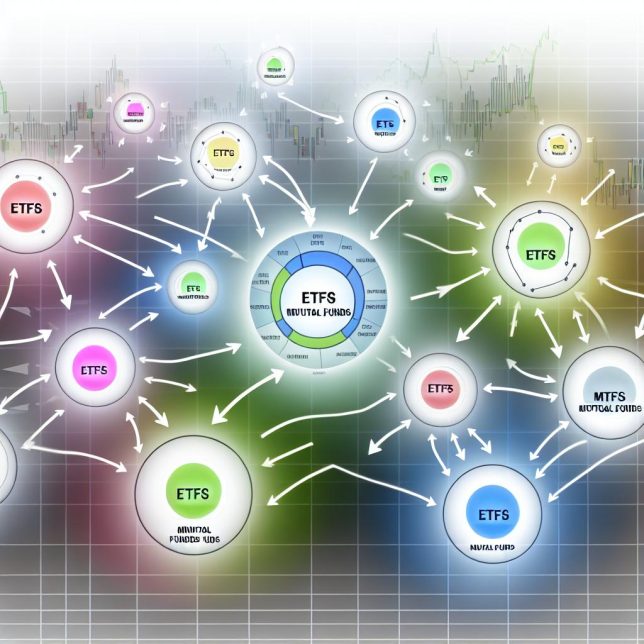The Role of ETFs and Mutual Funds in Portfolio Diversification
Diversification is a cornerstone strategy in managing investment risk, serving as a safeguard against market volatility by spreading exposure across a range of assets. Both Exchange-Traded Funds (ETFs) and Mutual Funds are pivotal in this pursuit. By understanding the intricacies and the potential benefits of these financial instruments, investors can optimize their portfolios for better stability and returns. This article delves into the specifics of how ETFs and Mutual Funds contribute to diversification.
Understanding ETFs and Mutual Funds
The first step in grasping the role of these instruments is to understand their individual characteristics.
Exchange-Traded Funds (ETFs) have the unique feature of being traded on stock exchanges akin to individual stocks. This means they can be bought and sold throughout the trading day at market prices, which can fluctuate based on supply and demand. An ETF is essentially a collection of securities that often follows an index, yet can encompass various assets such as stocks, bonds, or commodities. The goal of an ETF is to replicate the performance of an index or a particular benchmark, offering a relatively low-cost way to achieve market exposure. While generally designed to maintain a close alignment with the net asset value (NAV) of the holdings, market factors can occasionally cause deviations.
Mutual Funds, in contrast, are investment programs funded by pooling resources from many investors, with a professional manager or management team overseeing them. Unlike ETFs, mutual fund shares are not traded on a stock exchange but are purchased directly from the issuing company at the end of the trading day at a price equal to the NAV. These funds may engage in active or passive management, aiming for either a strategic outperformance of a benchmark index or simply to mirror it.
Investment in Broad Market Indices
One of the most significant advantages of ETFs and Mutual Funds is the exposure they provide to broad market indices. This is key to diversification, as it allows investors to spread their investments across a large number of securities within an index. For example, ETFs and mutual funds that track the S&P 500 offer investors the ability to hold interests in all the constituent companies of this index, which spans various sectors of the economy. This provides a level of diversification that’s difficult to achieve through individual stock investments.
Access to Various Asset Classes
ETFs and Mutual Funds enhance portability into multiple asset classes, such as equities, fixed income, commodities, and real estate. This capability is crucial for achieving diversification across asset classes, which can help manage risk by reducing dependency on the performance of a single market or sector. For instance, when the equity market faces downturns, investments in commodities or fixed income might perform differently, thereby balancing the portfolio.
Sector and Geographic Diversification
Beyond diversification across asset classes, ETFs and Mutual Funds also allow for sector-specific and geographic diversification. This is particularly beneficial for investors looking to focus on meaningful areas of the economy or develop international exposure. Sector-specific funds address areas like technology, healthcare, or finance, providing targeted exposure to industries expected to outperform the broader market. On the other hand, geographically-focused funds enable investors to participate in the economic growth of specific countries or regions, which can be pivotal in hedging against volatility in one’s domestic market.
Cost Efficiency and Liquidity
ETFs often stand out due to their cost efficiency and liquidity. Because they are generally passively managed, ETFs tend to have lower expense ratios than many actively managed mutual funds. Unlike mutual funds, which can only be traded at the end of the day, ETFs offer the flexibility to purchase and sell shares throughout the trading day, allowing investors to react swiftly to market changes. This intraday liquidity offers an advantage in terms of timing investments and managing capital more efficiently.
The Role of Professional Management
While many ETFs follow a passive management approach, relying on the inherent diversification and stability of a pre-determined index, mutual funds frequently engage in active management. This active oversight means fund managers regularly make decisions on buying or selling assets with the potential to outperform market indices. This can be particularly beneficial in unstable or complex markets where professional insights have the potential to lead to higher returns. For investors seeking nuanced strategies and tailored portfolio adjustments, actively managed mutual funds serve as a valuable tool.
Conclusion
In summary, ETFs and Mutual Funds play essential roles in the landscape of portfolio diversification. They offer investors the opportunity to achieve broad market exposure, diversify across numerous asset classes, and choose between the cost-effective nature of passive investing or the potentially rewarding aspects of active management. This versatility makes them indispensable for those seeking a well-rounded investment strategy. For investors looking to deepen their understanding or to begin incorporating these instruments into their portfolios, additional resources, such as those available on Investopedia or through consultation with a financial advisor, can provide valuable guidance. By making informed choices with ETFs and Mutual Funds, investors can secure a comprehensive approach to reducing risk and enhancing potential returns.
This article was last updated on: April 27, 2025

